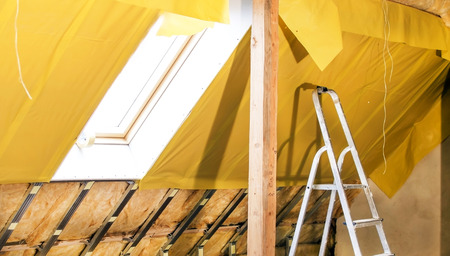Understanding Insulation in HVAC Systems
When it comes to optimizing HVAC performance and achieving meaningful energy savings, insulation plays a starring role. In the context of HVAC (Heating, Ventilation, and Air Conditioning), insulation refers to specialized materials installed within walls, attics, ducts, and even around pipes that act as barriers to heat flow. This means keeping the cool air in during those hot summer months and locking in warmth throughout chilly winters—essential for maintaining a consistent and comfortable indoor environment.
There are several types of insulation commonly used in American homes and commercial buildings: fiberglass batts, spray foam, rigid foam boards, and blown-in cellulose. Each type has its own benefits—fiberglass is budget-friendly and widely available, spray foam delivers superior air sealing, rigid foam boasts high R-values per inch, and blown-in cellulose excels at filling awkward nooks. The science behind how these materials work centers on their ability to slow down the transfer of heat through conduction, convection, and radiation. By trapping pockets of air or creating dense barriers, insulation reduces the workload on your HVAC system, minimizing energy consumption while enhancing year-round comfort.
2. The Impact of Insulation on Energy Efficiency
When it comes to optimizing HVAC performance and reducing home energy consumption, proper insulation acts as a game-changer. In the U.S., where heating and cooling account for nearly half of a typical homes energy use, even small improvements in insulation can lead to significant savings on utility bills. The U.S. Department of Energy (DOE) highlights that homeowners can save up to 15% on heating and cooling costs—an average of 11% on total energy bills—by sealing their homes and adding insulation in attics, floors over crawl spaces, and accessible basement rim joists.
How Insulation Makes a Difference
Insulation works by slowing the transfer of heat through walls, ceilings, and floors. In summer, it keeps cool air inside; in winter, it traps warmth. This means your HVAC system doesn’t have to work as hard to maintain a comfortable indoor temperature, translating directly into lower energy usage and cost.
Real-World Example: Midwest Home Renovation
A family in Chicago retrofitted their 1960s home with modern fiberglass insulation in the attic and exterior walls. Before the upgrade, their annual heating bill averaged $1,800. Afterward, it dropped to around $1,350—a reduction of $450 per year. This aligns with DOE projections and illustrates how investing in proper insulation pays off over time.
Comparing Energy Savings: With vs. Without Proper Insulation
| Home Type | Average Annual Heating/Cooling Cost | Estimated Savings After Upgrading Insulation |
|---|---|---|
| Poorly Insulated | $2,000 | – |
| Properly Insulated | $1,700 | $300 (15%) |
| Optimally Sealed & Insulated (DOE Best Practices) | $1,500 | $500 (25%) |
Key Takeaway:
The better your insulation, the less your HVAC system needs to run—and the more you save. According to the DOE’s Building Technologies Office, upgrading insulation is one of the most cost-effective ways to improve home efficiency and comfort, especially in regions with extreme temperatures.

3. Insulation Materials Commonly Used in American Homes
When it comes to boosting HVAC performance and maximizing energy savings, the choice of insulation material plays a pivotal role. Across the United States, homeowners and builders turn to a variety of insulation types, each offering unique benefits, R-values (a measure of thermal resistance), and best-fit applications for both residential and commercial spaces.
Fiberglass Insulation: The Classic Choice
Fiberglass insulation remains the most popular option in American homes due to its affordability, easy installation, and reliable performance. Typically found in batt or loose-fill forms, fiberglass boasts R-values ranging from R-2.9 to R-4.3 per inch, depending on density and format. It’s commonly used in attics, walls, floors, and ceilings, making it a versatile pick for retrofits and new constructions alike. In commercial settings, high-density fiberglass boards are often utilized for ductwork insulation.
Spray Foam Insulation: Superior Air Sealing
Spray foam insulation is celebrated for its exceptional air-sealing properties and higher R-values—open-cell spray foam offers around R-3.5 to R-3.7 per inch, while closed-cell variants can reach up to R-6.5 per inch. This material is ideal for hard-to-reach spaces, rim joists, and irregular cavities where traditional batts might fall short. In commercial buildings, spray foam not only insulates but also enhances structural integrity and moisture resistance.
Cellulose Insulation: Eco-Friendly Performance
Made primarily from recycled paper products, cellulose insulation is an environmentally conscious option that delivers solid thermal performance with R-values typically between R-3.2 and R-3.8 per inch. Blown-in cellulose works well in attic floors and wall cavities during retrofits, providing excellent coverage around obstacles such as wiring or pipes—a feature highly valued by both residential remodelers and commercial contractors seeking sustainability.
Rigid Foam Board: High Performance in Thin Layers
Rigid foam boards—including expanded polystyrene (EPS), extruded polystyrene (XPS), and polyisocyanurate—are favored for their high insulating power in limited spaces. Polyiso boards can achieve R-values up to R-6 or higher per inch, making them perfect for basement walls, exterior sheathing, or under slab installations where space is at a premium. Commercial projects often specify rigid boards for continuous insulation layers to eliminate thermal bridging.
Selecting the Right Material
The optimal insulation choice depends on regional climate, building type, budget constraints, and specific HVAC performance goals. Proper selection and installation are key to reducing heat loss or gain through your building envelope—directly impacting comfort levels and monthly utility bills.
4. How Insulation Improves HVAC Performance
When it comes to optimizing your homes HVAC system, insulation plays a starring role that goes well beyond just keeping things warm or cool. High-performance insulation creates a protective barrier that supports your HVAC unit in multiple ways—helping the system work smarter, not harder. This section connects the dots between top-tier insulation and improved HVAC operation, ultimately leading to reduced system wear, fewer maintenance headaches, and an extended lifespan for your equipment.
The Impact of High-Performance Insulation on HVAC Operation
Proper insulation reduces the amount of conditioned air that escapes your living spaces. When your home maintains its desired temperature with less energy loss, the HVAC system cycles on and off less frequently. This steady-state operation is crucial for both energy efficiency and the health of your mechanical equipment.
Key Benefits: System Wear, Maintenance, and Longevity
| Benefit | How Insulation Contributes |
|---|---|
| Reduced System Wear | Minimizes frequent cycling by maintaining consistent indoor temperatures, lowering stress on motors and components. |
| Lower Maintenance Needs | Prevents overworking of the system, resulting in fewer breakdowns and service calls throughout the year. |
| Extended Lifespan | Promotes steady operation under optimal conditions, which can add years to your HVAC unit’s operational life. |
Connecting Performance to Savings
The domino effect of good insulation is clear: when your HVAC doesn’t have to compensate for poor thermal barriers, it performs efficiently—and this efficiency translates into real-world savings. Over time, homeowners see fewer repair bills, experience more consistent comfort, and enjoy peace of mind knowing their investment will last longer. In essence, insulation is not just about comfort; it’s a long-term strategy for maximizing HVAC performance while minimizing costs.
5. Regional Considerations and Building Codes
When it comes to maximizing HVAC performance and energy savings, insulation isn’t a one-size-fits-all solution—especially across the diverse climate zones in the United States.
Climate Zones and Insulation Needs
The U.S. is divided into several climate zones, each with unique temperature ranges, humidity levels, and seasonal shifts. For example, homes in the frigid winters of Minnesota require higher R-value insulation to keep indoor warmth from escaping, while properties in Arizona’s desert climate benefit from insulation that keeps intense heat at bay and reduces air conditioning demand. In coastal regions like Florida, moisture resistance becomes just as critical as thermal performance. Understanding these regional differences ensures that insulation investments are both cost-effective and high-performing.
The Importance of Meeting Local Building Codes
Local building codes set minimum insulation standards based on regional climate data and energy efficiency goals. These codes aren’t just bureaucratic hurdles—they’re carefully crafted guidelines designed to protect homeowners’ comfort, health, and wallets. By adhering to local codes, property owners can ensure their buildings are equipped for optimal HVAC operation while minimizing unnecessary energy loss. Whether you’re remodeling or building new, meeting or exceeding code requirements is essential for long-term savings and compliance.
Energy Standards That Shape the Market
National programs like ENERGY STAR and state-level standards such as California’s Title 24 influence how insulation is selected and installed. These standards drive innovation in materials and encourage architects, builders, and homeowners to choose products that support sustainability and lower utility bills.
Regional Insight Equals Better Performance
Ultimately, tailoring your insulation choices to your specific location—and respecting all relevant building codes—is key to unlocking the full potential of your HVAC system. This approach not only enhances day-to-day comfort but also supports long-term energy savings and environmental stewardship.
6. Energy Savings: Case Studies and Practical Tips
Real-World Case Studies: Insulations Measurable Impact
Insulation isn’t just a theoretical benefit—it delivers tangible energy savings in homes and commercial spaces across the United States. For example, a recent study by the North American Insulation Manufacturers Association (NAIMA) revealed that upgrading attic insulation in a typical U.S. home led to an average annual energy savings of 15%. Another case, conducted in a Chicago-area office building, showed that adding high-performance insulation to exterior walls and HVAC ductwork reduced heating and cooling costs by over $5,000 per year—representing a 20% reduction in total energy consumption.
Actionable Tips for Homeowners
- Assess Your Current Insulation: Start with an inspection of attics, crawl spaces, and walls. Look for thin or missing insulation and address these gaps promptly.
- Seal Air Leaks: Use weatherstripping around doors and windows, and apply caulk to seal cracks where air might escape.
- Upgrade to High R-Value Materials: Choose insulation materials rated for your climate zone to maximize efficiency. The Department of Energy’s Insulation Fact Sheet offers helpful regional guidelines.
Best Practices for Facility Managers
- Perform an Energy Audit: Hire certified professionals to conduct comprehensive audits. This will identify weak points in your building envelope and prioritize upgrades.
- Insulate Ductwork: Exposed ducts in unconditioned spaces are notorious energy wasters. Wrapping them in appropriate insulation can reduce heat loss by up to 30%.
- Monitor Performance: Install smart thermostats and energy monitoring systems to track HVAC performance before and after insulation improvements.
The Bottom Line
The numbers don’t lie—effective insulation is one of the most cost-efficient ways to boost HVAC performance and cut energy bills. Whether you’re upgrading a family home or managing a large facility, investing in insulation pays dividends through lower utility costs, enhanced comfort, and a more sustainable footprint.


